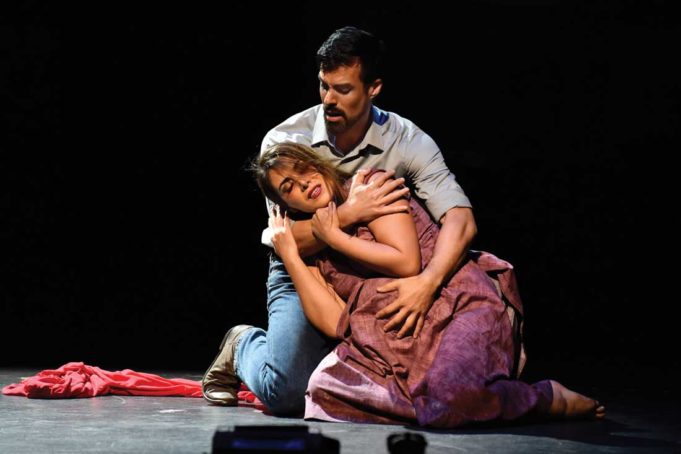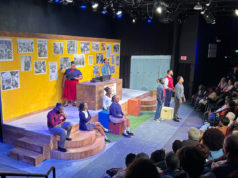The Fort Worth Opera Festival kicked off last Friday with a ravishing performance.
The first time María de Buenos Aires appeared in Fort Worth, it was in 2012 at Rose Marine Theater courtesy of Artes de la Rosa. Though skilled director Adam Adolfo did his best, he was handicapped by a limited budget. Fort Worth Opera’s rendition of Astor Piazzolla’s operetta was glorious. Conducted by Scott Terrell and choreographed and directed by John de los Santos, this María stayed true to Piazzolla’s vision of violence, love, and redemption while balancing the demands of rigorous dance choreography and music-driven drama.
The set was drab. Vestiges of graffitied sheet metal partitioned the viewable stage from the blackness beyond. Stage right was occupied by a chamber orchestra that skewed much of the action to the opposing side. The drama opened with an androgynous goblin (actress Gaby Natale) chanting, “Ahora es la hora” (“Now is the time”). Foreshadowing was omnipresent throughout the remaining 90 minutes. Nearby, a young María (5-year-old Ariana Zombar) viewed her conception, gazing emotionless from behind a chair as her mother is raped on the floor of a dingy apartment. Soon after, an older, strong María (soprano Solange Merdinian) blossomed onstage with a captivating performance of “Yo soy María de Buenos Aires!” Her carefully layered crescendos and the accompanying rising orchestral lines exuded confidence and an optimism that would later be mercilessly dismantled by the goblin. The first of several tango sequences ensued. Texas Ballet Theater’s Alex Danna and Riley Moyano athletically swept and cut before an amused-looking María.
In a dark apartment, El Payador (baritone Luis Alejandro Orozco) enticed María with soft, yearning tones in the tender ballad “Milonga Carrieguera.” She replied with Mozartian swells of counterpoint. They made love. Then she fled.
María’s fortunes began to fade after meeting a thief (Moyano) who led her to a seedy bordello in Buenos Aires. Her seductive power over men, conveyed dramatically by Merdinian’s bold gestures and confident vocal prowess, waned as drunken patrons realized they could have their way with her on their base terms. The once-optimistic seductress was reduced to prostitution.
The most affecting scene in the operetta was a surprise digression to a cemetery, La Recoleta Cementerio. As shrouded parents lit candles for deceased children, Paige Nyman delivered a poignant tango-tinged dance that personified grief and loss amid a string-driven orchestral lament. One moment of levity came soon after as the goblin took on the regalia of a Catholic archbishop extolling propaganda to the masses. A now-pregnant María entered only to find no sanctuary.
The plot of María is complicated-verging-on-convoluted. Timelines overlap and crisscross. But Santos kept things tight by utilizing a small cast who were relatively easy to follow. The orchestral score of María is home to several of Piazzolla’s most memorable melodies, which act as leitmotifs for the opera’s characters. The bandoneon (German by birth and later widely adopted in Argentina) was masterfully performed by Juan Pablo Jofre, who brought the mournful strains of the reed instrument to life.
The only significant glitches that night were technical. Since all of the singers were mic’d, some of the louder songs were slightly uncomfortable. The supertitles were inconsistent at times and were generally a distraction. Librettist Horacio Ferrer’s text is pure poetry but can be better enjoyed read separately. And a few entrances came off awkwardly due to late mic elevations.
The musicians performed splendidly. The three dancers were the highlight of the evening, though, rendering complicated steps (often in very close proximity) with flare while not allowing the results to look automated. Merdinian, who had what was certainly the most exhausting role, added depth to a character who risked coming off as objectified by the many lustful eyes that follow her throughout the operetta. Merdinian allowed her character to evolve, but she never let María appear pitiful. Her theatrics were carefully balanced, allowing the focus of the drama to shift away from her at times even while she was still on stage.
María de Buenos Aires is an astute choice for an opera company that has committed to programming Central and South American repertoire. It is a shame that there are only two performances of this work.
María de Buenos Aires
Sat at Bass Performance Hall, 525 Commerce St, FW. $17-75. 817-212-4200.












